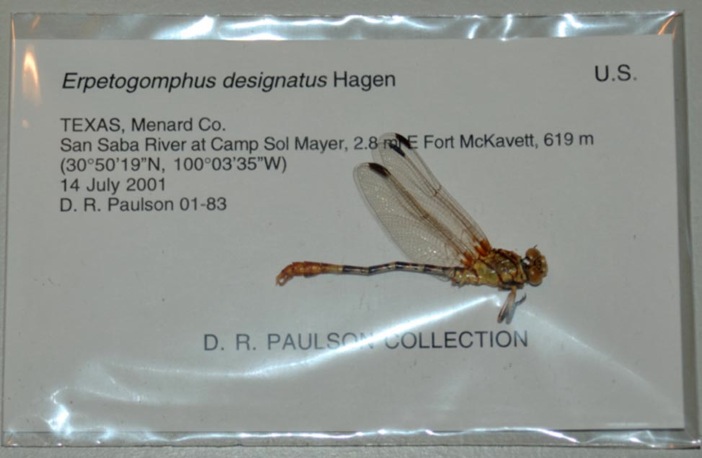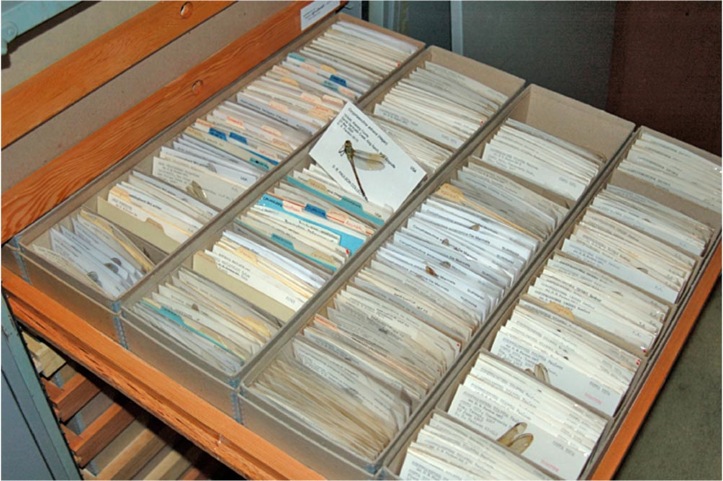Collecting Dragonflies (Odonata) and Maintaining a Collection
Dennis R. Paulson
Although not everyone will wish to do so, the best way to learn to identify dragonflies is by collecting them. Like butterflies, many species are easily identified in the field, but also like butterflies, some species may be identified only in the hand. The simplest way to learn their identity is to capture one, identify it in the hand, then either release it or "collect" it for a reference specimen. Take care not to catch tenerals (recently emerged individuals) unless you plan to keep them; they are very easily damaged if handled.
If you plan to collect specimens, there are procedures that you should follow so the specimens are of greatest value to you and to a larger collection to which you may someday donate them. There is little justification for killing a dragonfly except for education or research. At the same time, dragonflies are insects, the great majority of them are common, and there is little chance that scientific collecting affects their populations. Thus there is every justification for collecting dragonfly specimens to learn about them. The most important thing to remember is that these specimens, with appropriate data, are of value to science, and you should make provisions for eventually donating them to a museum, academic institution, or nature center of your choice.
It's important to remember that "dragonfly" refers to the entire order Odonata, and is thus inclusive of damselflies. "Odonate" is also often used for members of this group.
If you wish to make a collection, here is a summary of the steps to follow to collect a dragonfly for a specimen.
- Catch it
- Envelope it
- Acetone it
- Remove it
- Label it
- Store it
Here are the details.
1. Catch it
Dragonflies are subject to predation, particularly by birds, and they are accordingly quite wary. They have quick responses and quick flight, so you must be even quicker. Even damselflies may move away rapidly, although they are sometimes easily approached. Dragonflies are considerably warier.
Perched dragonflies are probably easier to catch than those already in flight. If an odonate is perched in the open, just sweep the net sideways, trying to center the intended victim. If it is in dense vegetation, the best strategy is to come down from above, as a sideways sweep may just flip the vegetation out of the net, the insect with it. If it is perched on a stout branch, there is every chance you will knock it out of the net when you hit the branch, so extra thought may be needed to figure out your best capture strategy. After you catch it, lift the end of the net and the dragonfly will often fly up into it. Grasp the net below the dragonfly and turn it over so you can reach in and grab it. If you are very concerned about not losing it, grab it from outside the net first. They tend to fly up, and many a dragonfly has escaped instantly when the collector opens the bag to look inside!
For a dragonfly in flight, sweep sideways and quickly flip the net bag over, trapping it inside. It's always best to swing from behind and below, the area of poorest vision. Both feeding individuals and those in sexual patrol flights may fly a regular beat, so you can anticipate their flight path.
You can usually grab any dragonfly with impunity, but the larger ones have big mandibles and can pinch enough to generate four-letter words such as "ouch." Only a few of the largest species can actually draw blood when they bite, and you'll learn about them quickly enough (huge female spiketails are surely the fiercest in the Pacific Northwest). If you're concerned, just watch what you are doing, and grab them by the wings. Their wings are quite strong, without the shedding scales of butterflies.
2. Envelope it
Place it, wings folded back, in a glassine (stamp or coin) envelope labelled with locality and date. To save time and for recordkeeping, I use a field number for each collection--96-1, 96-2, etc., for my 1996 collections. You can put more than one individual per envelope, but if the mandibles of one contact the body of the other, it may start chewing (aha, food!). I write "T" on the envelope for pairs in tandem, "C" for pairs in copula, as it is important to keep track of pairs. Such pairs should be kept together (or their identity noted if too big to be put in one envelope). Make sure you have a pen with indelible ink.
3. Acetone it
After leaving your specimens in their envelopes for a while (for example, until you return home at night) so they can void their intestinal contents, kill them by immersing them briefly in acetone. Straighten the abdomen of each specimen, arranging the legs so they don't obscure the genitalia on the second abdominal segment of males. Put them back in their labelled envelopes and leave them submerged in acetone in a tightly closed plastic (e.g., Rubbermaid) container for 16-24 hours. You should cut off a bit of each lower corner of the envelope so the acetone enters readily and drains when you lift the envelope out.
Acetone extracts fat and water from specimens, and they dry much better and with better color preservation than when merely air-dried. Avoid breathing of acetone fumes; a little must not be too harmful, as dragonfly collectors don't seem much weirder than other people.
Specimens with extensive pruinosity may become discolored in acetone. In particular, spreadwing damselflies (Lestidae) and a few pruinose skimmers such as the Common Whitetail, Plathemis lydia, change color rather drastically, and you may prefer not to place them in acetone. On the other hand, I have had some individual dragonflies retain their pruinosity after acetone treatment, perhaps when the acetone is freshest. It eventually contains quite a bit of grease, and as it becomes yellowish you should replace it for best preservation.
4. Remove it
Remove your specimens from the acetone, letting all the liquid drain out, and leave them in the open for a few days so the acetone will evaporate. Preferably have a well-ventilated spot away from people as it evaporates. Try to separate the envelopes for quickest evaporation. All dried dragonfly specimens are stiff and brittle, although those that have been acetoned are stronger and more resistant to breakage.
An alternative: If you are unwilling or unable to use acetone (sometimes the case when traveling), an alternative is: (3-4) Let the dragonfly die in the envelope; by excreting feces from its abdomen, the abdomen dries better. Make sure the abdomen is straightened out rather than curved. Put it in a dry place to dry thoroughly; it's stiff and brittle when dry, so take care. Putting then under (or above) a heat lamp is a good way to dry specimens, but attempts at using an oven often result in discolored specimens. After drying, then go to 5 & 6.]
5. Label it
All specimens should have the following information associated with them: species name (if you know it; can be changed if reidentified), locality (in some detail, including mileage from known location, lake/pond or river/stream name, elevation and latitude/longitude), date, and collector. Include your field number if you use them for collections. Many collectors include habitat notes, at the very least something like "pond" or "slow, sandy stream" or "flying over clearing." It is also of interest to associate habitat and time of day. In fact, the more information that can be associated with each specimen, the better. Mating pairs in tandem or in copula should always be so indicated and should be stored together unless too large.
6. Store it
Store your specimens in a box protected from both humidity and possible pests such as carpet beetles or mice. For more useful and elegant storage, after they are dry switch them to "Odonata specimen envelopes" (available from several sources, see the Odonata Information Network Store) with the collecting information written, typed, or printed on a 3x5 card; the specimen can then be examined without taking it out of the envelope.
You can devise your own storage system for your specimens. I use custom-made boxes that would hold 3x5 cards, kept in museum specimen cases, but others keep them in boxes of appropriate sizes with a few mothballs in each box, stored on a shelf or in a cabinet or drawer. If you think your home is pestfree, you can take your chances without mothballs, but you should check for bug damage frequently to confirm this.
For pinned specimens of dragonflies, the wings were always spread, which is logical. But there are several reasons why people don't spread them in enveloped specimens:
- If the wings are spread, the thorax + legs are perpendicular to the envelope, which bulges the envelope out more than it would if the specimen were sideways (a problem of storage space) and almost always leads to legs being broken off. This would be even worse with damselflies.
- The terminal appendages of many species are illustrated from the side, and that view often provides identification (although so does a dorsal or ventral view, but these may be less often illustrated).
- Some species would be too large for a 3x5 envelope!
Ideally, at least a few specimens should be stored with wings out, for photography, drawing, and dorsal or ventral views of the specimens without having to remove them from the envelope. Also, at least a few specimens of odonates with patterned wings should be stored with wings outspread. This is of special importance in some species, mostly damselflies, that have the upper wing surface differently colored than the lower, in some cases spectacularly iridescent.
The head usually ends up bent at 90 degrees with regard to the thorax, so you should try to store some specimens showing the top of the head, others the bottom. Also store about half facing left, half facing right, again to reduce the amount of space they take up in the box.
To examine the venation of just one side, all you have to do is remove the specimen from the envelope and carefully (from front to back) slide a piece of white paper or card between the left and right wing pairs.
Collecting equipment
BioQuip is the best source of entomological supplies. Contact them, and they will send you a catalog containing more items than you could possibly have imagined. However, I recommend you get dragonfly envelopes from the International Odonata Research Institute, as the BioQuip envelopes are slightly wider than the standard envelopes that have been used for many years and will not fit in some collection boxes. The best net for overseas travel is the Collapsible Tropics Net made by Rose Entomology. A larger, longer-handled net is always better for Odonata, but one with a reach of 5-6' and a rim of 15-18" in diameter serves very well.

